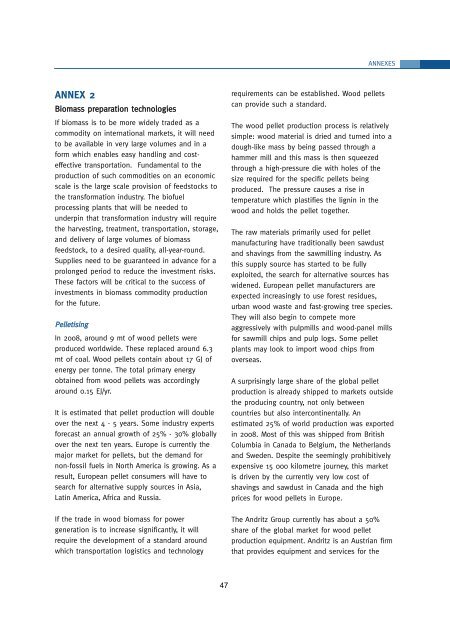Renewable Energy in Industrial Applications â an ... - Unido
Renewable Energy in Industrial Applications â an ... - Unido
Renewable Energy in Industrial Applications â an ... - Unido
Create successful ePaper yourself
Turn your PDF publications into a flip-book with our unique Google optimized e-Paper software.
ANNEXES<br />
ANNEX 2<br />
Biomass preparation technologies<br />
If biomass is to be more widely traded as a<br />
commodity on <strong>in</strong>ternational markets, it will need<br />
to be available <strong>in</strong> very large volumes <strong>an</strong>d <strong>in</strong> a<br />
form which enables easy h<strong>an</strong>dl<strong>in</strong>g <strong>an</strong>d costeffective<br />
tr<strong>an</strong>sportation. Fundamental to the<br />
production of such commodities on <strong>an</strong> economic<br />
scale is the large scale provision of feedstocks to<br />
the tr<strong>an</strong>sformation <strong>in</strong>dustry. The biofuel<br />
process<strong>in</strong>g pl<strong>an</strong>ts that will be needed to<br />
underp<strong>in</strong> that tr<strong>an</strong>sformation <strong>in</strong>dustry will require<br />
the harvest<strong>in</strong>g, treatment, tr<strong>an</strong>sportation, storage,<br />
<strong>an</strong>d delivery of large volumes of biomass<br />
feedstock, to a desired quality, all-year-round.<br />
Supplies need to be guar<strong>an</strong>teed <strong>in</strong> adv<strong>an</strong>ce for a<br />
prolonged period to reduce the <strong>in</strong>vestment risks.<br />
These factors will be critical to the success of<br />
<strong>in</strong>vestments <strong>in</strong> biomass commodity production<br />
for the future.<br />
Pelletis<strong>in</strong>g<br />
In 2008, around 9 mt of wood pellets were<br />
produced worldwide. These replaced around 6.3<br />
mt of coal. Wood pellets conta<strong>in</strong> about 17 GJ of<br />
energy per tonne. The total primary energy<br />
obta<strong>in</strong>ed from wood pellets was accord<strong>in</strong>gly<br />
around 0.15 EJ/yr.<br />
It is estimated that pellet production will double<br />
over the next 4 - 5 years. Some <strong>in</strong>dustry experts<br />
forecast <strong>an</strong> <strong>an</strong>nual growth of 25% - 30% globally<br />
over the next ten years. Europe is currently the<br />
major market for pellets, but the dem<strong>an</strong>d for<br />
non-fossil fuels <strong>in</strong> North America is grow<strong>in</strong>g. As a<br />
result, Europe<strong>an</strong> pellet consumers will have to<br />
search for alternative supply sources <strong>in</strong> Asia,<br />
Lat<strong>in</strong> America, Africa <strong>an</strong>d Russia.<br />
If the trade <strong>in</strong> wood biomass for power<br />
generation is to <strong>in</strong>crease signific<strong>an</strong>tly, it will<br />
require the development of a st<strong>an</strong>dard around<br />
which tr<strong>an</strong>sportation logistics <strong>an</strong>d technology<br />
requirements c<strong>an</strong> be established. Wood pellets<br />
c<strong>an</strong> provide such a st<strong>an</strong>dard.<br />
The wood pellet production process is relatively<br />
simple: wood material is dried <strong>an</strong>d turned <strong>in</strong>to a<br />
dough-like mass by be<strong>in</strong>g passed through a<br />
hammer mill <strong>an</strong>d this mass is then squeezed<br />
through a high-pressure die with holes of the<br />
size required for the specific pellets be<strong>in</strong>g<br />
produced. The pressure causes a rise <strong>in</strong><br />
temperature which plastifies the lign<strong>in</strong> <strong>in</strong> the<br />
wood <strong>an</strong>d holds the pellet together.<br />
The raw materials primarily used for pellet<br />
m<strong>an</strong>ufactur<strong>in</strong>g have traditionally been sawdust<br />
<strong>an</strong>d shav<strong>in</strong>gs from the sawmill<strong>in</strong>g <strong>in</strong>dustry. As<br />
this supply source has started to be fully<br />
exploited, the search for alternative sources has<br />
widened. Europe<strong>an</strong> pellet m<strong>an</strong>ufacturers are<br />
expected <strong>in</strong>creas<strong>in</strong>gly to use forest residues,<br />
urb<strong>an</strong> wood waste <strong>an</strong>d fast-grow<strong>in</strong>g tree species.<br />
They will also beg<strong>in</strong> to compete more<br />
aggressively with pulpmills <strong>an</strong>d wood-p<strong>an</strong>el mills<br />
for sawmill chips <strong>an</strong>d pulp logs. Some pellet<br />
pl<strong>an</strong>ts may look to import wood chips from<br />
overseas.<br />
A surpris<strong>in</strong>gly large share of the global pellet<br />
production is already shipped to markets outside<br />
the produc<strong>in</strong>g country, not only between<br />
countries but also <strong>in</strong>tercont<strong>in</strong>entally. An<br />
estimated 25% of world production was exported<br />
<strong>in</strong> 2008. Most of this was shipped from British<br />
Columbia <strong>in</strong> C<strong>an</strong>ada to Belgium, the Netherl<strong>an</strong>ds<br />
<strong>an</strong>d Sweden. Despite the seem<strong>in</strong>gly prohibitively<br />
expensive 15 000 kilometre journey, this market<br />
is driven by the currently very low cost of<br />
shav<strong>in</strong>gs <strong>an</strong>d sawdust <strong>in</strong> C<strong>an</strong>ada <strong>an</strong>d the high<br />
prices for wood pellets <strong>in</strong> Europe.<br />
The Andritz Group currently has about a 50%<br />
share of the global market for wood pellet<br />
production equipment. Andritz is <strong>an</strong> Austri<strong>an</strong> firm<br />
that provides equipment <strong>an</strong>d services for the<br />
47

















